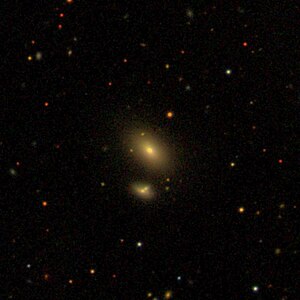NGC 7387
| Galaxy NGC 7387 |
|
|---|---|

|
|
| SDSS recording | |
| AladinLite | |
| Constellation | Pegasus |
|
Position equinox : J2000.0 , epoch : J2000.0 |
|
| Right ascension | 22 h 50 m 17.6 s |
| declination | + 11 ° 38 ′ 12 ″ |
| Appearance | |
| Morphological type | S0: |
| Brightness (visual) | 14.3 mag |
| Brightness (B-band) | 15.3 mag |
| Angular expansion | 0.7 ′ × 0.4 ′ |
| Position angle | 48 ° |
| Surface brightness | 12.8 mag / arcmin² |
| Physical data | |
| Affiliation | NGC-7386 group |
| Redshift | 0.023743 +/- 0.000037 |
| Radial velocity | 7118 +/- 11 km / s |
|
Stroke distance v rad / H 0 |
(326 ± 23) x 10 6 ly (99.8 ± 7.0) Mpc |
| history | |
| discovery | RJ Mitchell |
| Discovery date | September 9, 1856 |
| Catalog names | |
| NGC 7387 • PGC 69834 • CGCG 430-019 • MCG + 02-58-022 • 2MASX J22501765 + 1138125 • LDCE 1538 NED003 | |
NGC 7387 is a lenticular galaxy of the Hubble type S0 in the constellation Pegasus in the northern sky . It is estimated to be 326 million light years away from the Milky Way and has a diameter of about 65,000 ly. With NGC 7386 it forms a gravitationally bound galaxy pair.
In the same area of the sky are the galaxies NGC 7383 , NGC 7385 , NGC 7389 , NGC 7390 , among others .
The object was discovered on September 9, 1856 by RJ Mitchell , an assistant to William Parsons .
